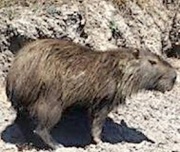Difference between revisions of "Capybara"
Jump to navigation
Jump to search
(username removed) |
m (Text replace - "== Authority ==" to "== Sources Checked for Data in Record ==") |
||
| Line 12: | Line 12: | ||
Bristle holes occur in straight-line groups, usually 4 to 7 holes to a group. | Bristle holes occur in straight-line groups, usually 4 to 7 holes to a group. | ||
| − | == | + | == Sources Checked for Data in Record == |
* G.S.Brady, ''Materials Handbook'', McGraw-Hill Book Co., New York, 1971 Comment: p. 447 | * G.S.Brady, ''Materials Handbook'', McGraw-Hill Book Co., New York, 1971 Comment: p. 447 | ||
Revision as of 13:30, 29 April 2016
Description
Skins from small wild rodents of the cava family, Hydrochoerus capybara, native to tropical South America. Capybara skins resemble pigskins. They are used for belting, gaskets, sporting gloves, and other small items.
Synonyms and Related Terms
capibara (Ned); carpincho leather; capivara;
Other Properties
Bristle holes occur in straight-line groups, usually 4 to 7 holes to a group.
Sources Checked for Data in Record
- G.S.Brady, Materials Handbook, McGraw-Hill Book Co., New York, 1971 Comment: p. 447
- Howard L. Needles, Handbook of Textile Fibers, Dyes & Finishes, Garland Publishing Co., New York, 1981
- Edward Reich, Carlton J. Siegler, Consumer Goods: How to Know and Use Them, American Book Company, New York City, 1937
- Website address 1 Comment: American Leather Chemists Association Glossary at www.leatherchemists.org
- Van Nostrand's Scientific Encyclopedia, Douglas M. Considine (ed.), Van Nostrand Reinhold, New York, 1976
- Random House, Webster's Encyclopedic Unabridged Dictionary of the English Language, Grammercy Book, New York, 1997
- The American Heritage Dictionary or Encarta, via Microsoft Bookshelf 98, Microsoft Corp., 1998
